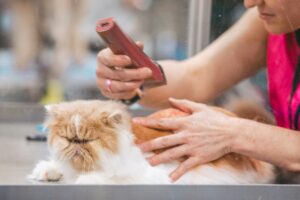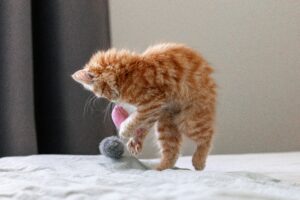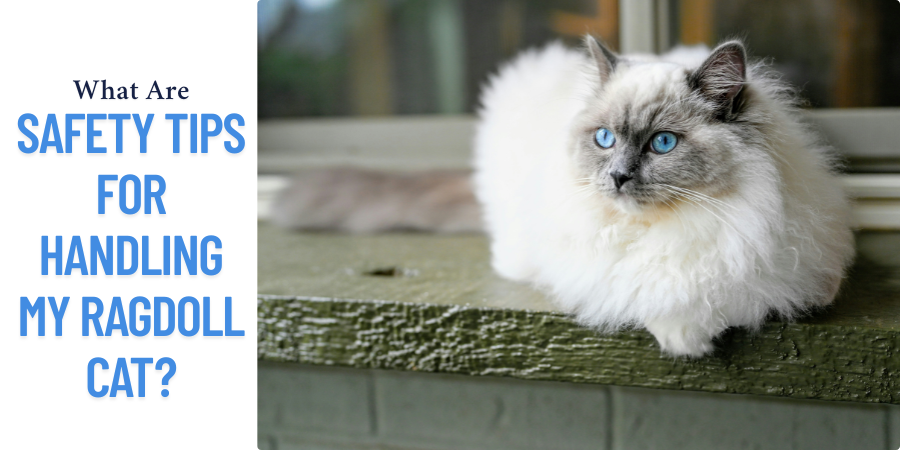When I first adopted my Ragdoll cat, I was drawn to her blue eyes, soft coat, and relaxed temperament—a true reminder of the breed’s origin by Ann Baker back in the 1960s, California. This delightful breed is known for its affectionate, playful, and gentle nature, often going completely limp when cuddled. However, providing proper support while holding is vital, especially for females, males, or even first-time owners. It’s important to evenly distribute their weight using both hands—one under the chest, the other supporting the hindquarters to maintain comfort and a secure hold.
Despite their laid-back attitude, Ragdolls have emotional needs, physical needs, and a loving personality that thrive with interaction, mental stimulation, and regular grooming. Following a care guide with tips like a high-protein diet, routine vet visits, and gentle handling techniques enhances their well-being. Based on advice from professionals like Dr Jane Miller, BSc, BVSc, meeting their basic requirements, from nutrition to secure handling—creates a positive experience for both cats and owners. Whether walking on a leash, teaching tricks, or maintaining their health care, knowing your floppy cat’s unique temperament helps build a secure, trusting bond.
Contents
- 1 Why Ragdoll Cats Need Gentle Handling
- 2 Understanding the Ragdoll Cat’s Temperament
- 3 How to Properly Lift and Hold a Ragdoll Cat
- 4 Top Safety Tips for Handling a Ragdoll Cat Daily
- 5 Safe Grooming Practices for Your Ragdoll Cat
- 6 Signs Your Ragdoll Feels Uncomfortable or Unsafe
- 7 Teaching Children to Safely Interact with Ragdoll Cats
- 8 Creating a Safe Playtime Environment for Your Cat
- 9 Monitoring Health: Why It Matters for Safe Handling
Why Ragdoll Cats Need Gentle Handling
With Ragdoll cats, what truly matters is handling them in a gentle and careful manner, especially when they go completely limp—a trait that’s as unique as it is endearing. Their semi-long fur, blue eyes, and docile personality might suggest they love being picked up anytime, but the truth is, not every feline enjoys it unless done with understanding and respect.
To build a strong bond, always hold them securely to ensure their comfort and safety, giving them the joy of being truly cuddled. Ragdoll cats are among the most affectionate cat breeds, and to properly care for them, it’s essential to create a healthy relationship based on trust, well-being, and shared companionship. Simply put, to enjoy their calm and relaxed nature, how they are handled is just as important as how much they’re loved.
Understanding the Ragdoll Cat’s Temperament
Having lived with Ragdoll cats for years, I’ve found their calm and gentle temperament makes them ideal companions. These laid-back felines rarely show unwanted behaviours, but it’s still important to address occasional quirks early on. As you learn to guide and begin managing their unique characteristics, you’ll discover that offering proper care builds a deeper understanding of your Ragdoll’s needs. Sometimes they get carried away during playtime, leading to unintentional scratches or rough behaviour, but it’s usually all in fun. Just setting boundaries and using interactive toys to redirect that burst of energy away from your hands can encourage more positive play habits. With consistent redirection, they quickly learn what’s acceptable, making it easier for you to focus on keeping playtime safe and enjoyable.
While they’re known as curious cats, their trusting and laid-back nature can make them vulnerable when exploring the outdoors. Due to these potential dangers, I always keep mine indoors or take them on supervised walks with a harness. A secure outdoor enclosure also helps satisfy curiosity while ensuring safety. Their cheeky, playful nature means they may make a mess, like knocking things over when seeking entertainment, so it’s smart to keep fragile items, liquids, and chemicals well out of reach, especially when they’re unsupervised. With basic training and a calm environment, tools like pheromone diffusers (I recommend Feliway) can reduce overstimulation and promote relaxation. And if you have adventurous Ragdolls, offering supervised outdoor time, whether on a harness or inside a secure enclosure, can truly fulfil curiosity while still ensuring safety.
How to Properly Lift and Hold a Ragdoll Cat
Over the years of caring for my Ragdoll cat, I’ve learned that handling these gentle companions requires more than just affection—it demands proper lifting techniques. To ensure a comfortable experience, always place one hand under the chest and the other beneath the hindquarters. This delicate balancing act not only helps prevent discomfort or injury but also allows for a successful interaction with your feline friend. Maintain a firm grip, but be sure to handle with care and lift gently to avoid startling your cat. Following these guidelines guarantees a safe and smooth hold.
Equally important is proper hand placement and secure body support. Always use both hands, positioned securely, to support the Ragdoll cat’s body. This technique helps distribute weight evenly, preventing stress on their limbs and keeping your cat relaxed. A gentle touch, stable support, and right-hand placement are vital in building a strong bond and keeping your feline companion comfortable. Approach calmly, move gently, and with confidence and ease, create a pleasant holding experience that supports a positive relationship.
Top Safety Tips for Handling a Ragdoll Cat Daily
If you’ve welcomed a Ragdoll cat into your life, you already know how gentle and relaxed they can be. But daily handling requires more than just affection—it calls for a thoughtful and safe approach that ensures your cat’s well-being. From the way you lift and support the body to how you stimulate their instincts through play, every action matters. Let’s walk through the key ways to create a positive experience for both you and your feline companion.
|
Safety Tip |
Why It Matters |
| Use both hands to support the entire body | Keeps the cat secure, comfortable, and prevents injury |
| Avoid sudden movements or rough handling | Maintains a sense of trust and keeps your Ragdoll relaxed |
| Gently lift and put down | Shows understanding and respect for your cat’s boundaries |
| Incorporate feather wands and interactive toys | Stimulate instincts, make play enjoyable, and promote exercise |
| Keep grooming sessions calm and regular | Enhances bonding, ensures comfort, and supports routines |
| Observe their body language | Helps you recognize when they feel safe or need space |
| Offer positive handling experiences daily | Builds a strong connection and improves your cat’s overall well-being |
| Create a relaxed environment | Supports your cat’s nature and helps them truly enjoy your company |
Daily handling should always reflect comfort, respect, and an understanding of your cat’s unique personality. By being gently intentional and engaging in meaningful activities, your Ragdoll will not only feel supported but will grow to see you as a source of safety, fun, and unwavering companionship.
Safe Grooming Practices for Your Ragdoll Cat
To ensure your Ragdoll stays healthy and happy, always use a gentle approach when handling their silky, semi-long fur. While they are considered a low-maintenance member of long-haired breeds, regular attention to their coats helps prevent matting and keeps their appearance at its best. With regular care, even during seasonal changes, you can easily manage loose hair by using soft tools like wide-toothed combs or grooming mitts.

Make brushing a relaxing and positive bonding experience with your feline friend by keeping sessions short and consistent. Their coat stays smooth and tangle-free with gentle strokes, especially if you groom them before they shed excessively. It’s essential to be calm and patient; this makes the process easy and enjoyable, both for you and your cat. You’ll quickly see them looking better, and they’ll feel more at ease being handled.
Signs Your Ragdoll Feels Uncomfortable or Unsafe
It’s not always easy to tell when Ragdoll cats feel unsafe, especially since their typically docile nature can hide signs of discomfort. But if your furry friend starts hiding, avoiding interaction, or shows changes in behavior, they may be feeling overwhelmed. From stress due to loud noises or new surroundings to sudden routine changes, it’s important to stay alert and understand their quiet signals. Recognizing these early helps protect their well-being and supports their emotional health.
- Excessive Grooming: Repeated licking or scratching may cause bald spots, skin irritation, or even infections, indicating emotional or physical discomfort.
- Hiding Behavior: Seeking dark corners or slipping under beds could mean your Ragdoll is feeling anxious or stressed by loud sounds, new pets, or people.
- Eating Changes: Sudden overeating, loss of appetite, weight gain, or weight loss might point to medical issues or a stressed coping mechanism.
- Aggressive Reactions: Hissing, swatting, or biting when approached can signal they feel unsafe—respond with positive reinforcement like treats and soft play.
- Litter Box Issues: If they start avoiding the litter box, urinating, or pooping outside it, it could reflect discomfort, UTIs, or emotional unrest.
- Vocalizations: Nonstop meowing, yowling, or other loud sounds may be your cat’s way of saying they’re lonely, hungry, or in pain.
- Unusual Vomiting/Diarrhea: These physical signs could indicate stress-related illness, gastrointestinal distress, or something that needs a vet check.
- Lack of Interest in Play: A once active Ragdoll suddenly ignoring interactive toys or not enjoying quality time may be withdrawing due to emotional strain.
Also Read: Why Is My Kitten Breathing Heavy in Her Sleep?
Your Ragdoll may not always show clear signs when something’s wrong, but small changes in routine, behavior, or health can speak volumes. Staying gentle, offering calm spaces, and paying attention to their needs will help create a secure, loving home where your Ragdoll feels completely safe.
Teaching Children to Safely Interact with Ragdoll Cats
In homes with young children, it’s important to take extra precautions when handling a Ragdoll cat, as their natural tolerance and patience can sometimes be misunderstood. From my experience as a parent and pet owner, I’ve found that teaching kids the value of being gentle goes a long way. Always support the body of the cat and avoid squeezing, no matter how cuddly your Ragdoll looks.
Children should be instructed to recognize when a cat has had enough, especially when it flicks its tail, flattens its ears, or tries to move away. These signs often indicate the need to stop handling and simply give space. Close supervision is key to prevent accidental or rough handling while they interact, and understanding a cat’s body language should be a fun and ongoing part of your family routine.
Safety Tips for Handling Ragdolls During Vet Visits or Travel
Traveling or going to the vet clinic can bring stress and anxiety to gentle Ragdolls, but smart comfort measures can make it more tolerable. Starting with short drives, place your cat in a secure carrier on the car floor or seat, cushioned with a blanket carrying familiar scents like your worn T-shirt. Keep a calm environment by using soft music, a white noise app, or even calming music like classical music to mask unsettling sounds and traffic. Repeated exposure helps your Ragdoll become accustomed—regularly take non-vet-related trips to the park or do car rides to dissociate the experience from fear.
- Car Preparation:
- Place carrier on car floor or seat for stability
- Use blanket with familiar scent (T-shirt works well)
- Block visual stimuli with a cover but ensure ventilation
- Practice Travel:
- Do short, regular drives to non-vet places
- Avoid feeding heavy food before long trip to reduce motion sickness
- Limit hours in car and bring along comfort items
- Minimize Vet Day Chaos:
- Choose a cat-friendly vet with Fear Free certification
- Schedule quieter times like early mornings to avoid crowded waiting rooms
- Call ahead to request a quiet exam room based on temperament
Once at the clinic, reduce the chance of overwhelm in the waiting area. Bring toys, a toy, or a calming spray such as Feliway, which is a synthetic feline pheromone shown to soothe cats. Use natural calming methods such as a gentle touch or petting, and remain composed—your emotions influence your pet. Speaking softly with a relaxed demeanor during the visit will help reassure your Ragdoll.
- Clinic Environment:
- Cover the carrier to block new sights and smells
- Bring familiar comfort items or toys
- Wait in the car until your appointment to reduce exposure
- Use Calming Techniques:
- Try pheromone products like the Feliway diffuser at home
- Play cat-specific relaxation tracks before vet visits
- Practice handling techniques that maintain a low-stress experience
- Support During Visit:
- Pet with slow stroke movements
- Use newly discovered products only after veterinarian approval
- Reinforce consistent practice so your cat links travel to safety
Creating a Safe Playtime Environment for Your Cat
When it comes to playtime with your Ragdoll cat, ensuring safety is key. Their gentle nature makes them less rough than other cats, so it’s important to avoid turning your hands into play objects, which could lead to accidental bites or scratches. Instead, opt for interactive toys like feather wands or soft plush toys—these are not only safe toys but also make the entire playtime an enjoyable experience for both of you.

From my experience, setting up a secure space free of hazardous objects and making sure furniture is stable can drastically help in minimizing risks during play sessions. A calm, open area gives your cat the freedom to move while reducing the chances of injuries or accidents. Consistency in creating a positive routine helps build trust and makes your Ragdoll more playful and confident.
Monitoring Health: Why It Matters for Safe Handling
When it comes to handling your Ragdoll cats, keeping an eye on their overall well-being is just as important as being gentle. Their calm nature can sometimes hide health issues, so it’s crucial for owners to monitor them closely. Staying informed builds awareness around common conditions, helping spot early signs before they impact your handling routine or the cat’s comfort.
- Bladder Stones and Urinary Issues
Watch for pain, vocalising, or trouble in the bathroom, especially if you notice blood in the urine or frequent visits to the litter box. Offering fresh water daily and a veterinary-approved diet can ease discomfort and reduce the chance of recurrence. - Heart Conditions in Ragdoll Cats
Feline hypertrophic cardiomyopathy (HCM), a genetic heart condition, is a risk in the Ragdoll cat breed. It causes the heart’s walls to thicken, affecting function. Symptoms like low energy, laboured breathing, or heart murmurs often appear in older male Ragdolls, though younger cats can be affected too. Genetic testing and regular veterinary check-ups help detect it early, improving management. - Weight, Diet, and Diabetes Prevention
Weight gain can lead to diabetes, so regulation of food and treats is key. Use puzzle treats and smart feeding bowls to control how much and how fast they eat. Encourage daily physical activity to keep them agile and healthy. - Dental Care and Gum Disease
Gum disease is a serious issue in cats that often goes unnoticed. Your furry friend should be regularly examined to decrease the likelihood of it becoming severe. Brush teeth when possible, and book dental scale and polish treatments if advised by your vet.
Paying attention to even subtle changes in your Ragdoll’s behavior or appearance ensures smoother, safer handling. These health insights not only help avoid stress during cuddles or grooming but also boost your cat’s happiness and quality of life every day.

